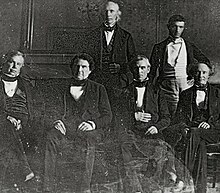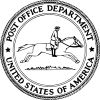This is the current revision of this page, as edited by JacktheBrown (talk | contribs) at 05:16, 15 December 2024 (Undid revision 1263186159 by 2600:1700:B1C0:F1C0:4D96:7E0:8D92:7C (talk) not necessary). The present address (URL) is a permanent link to this version.
Revision as of 05:16, 15 December 2024 by JacktheBrown (talk | contribs) (Undid revision 1263186159 by 2600:1700:B1C0:F1C0:4D96:7E0:8D92:7C (talk) not necessary)(diff) ← Previous revision | Latest revision (diff) | Newer revision → (diff) American politician (1793–1866) For the video game character, see Cave Johnson (Portal).| Cave Johnson | |
|---|---|
 | |
| 12th United States Postmaster General | |
| In office March 6, 1845 – March 4, 1849 | |
| President | James K. Polk |
| Preceded by | Charles A. Wickliffe |
| Succeeded by | Jacob Collamer |
| Member of the U.S. House of Representatives from Tennessee | |
| In office March 4, 1839 – March 3, 1845 | |
| Preceded by | Richard Cheatham |
| Succeeded by | Lucien Bonaparte Chase |
| Constituency | 9th district (1843–1845) 11th district (1839–1843) |
| In office March 4, 1829 – March 3, 1837 | |
| Preceded by | John Hartwell Marable |
| Succeeded by | Richard Cheatham |
| Constituency | 11th district (1833–1837) 8th district (1829–1833) |
| Personal details | |
| Born | (1793-01-11)January 11, 1793 Tennessee County, Southwest Territory, U.S. |
| Died | November 23, 1866(1866-11-23) (aged 73) Clarksville, Tennessee, U.S. |
| Political party | Democratic |
| Spouse | Elizabeth Dortch Brunson |
| Education | Cumberland College |
| Signature | |
Cave Johnson (January 11, 1793 – November 23, 1866) was an American politician who served the state of Tennessee as a Democratic congressman in the United States House of Representatives. Johnson was the 12th United States Postmaster General in the administration of James K. Polk from 1845 to 1849.
Early life
Johnson was born near present-day Springfield, Tennessee to Robert and Mary Noel Johnson. He was named for Rev. Richard Cave, a Baptist minister in the Travelling Church with whom Mary's mother, also named Mary Noel, had been acquainted in Kentucky. He suspected but could never prove a relation to William Cave Johnson of Boone County, Kentucky. He was studying at Cumberland College when the War of 1812 began, and organized a band of volunteers that Andrew Jackson declined. In 1813 he joined his father's militia unit in the Creek War, returning to Nashville the next year to complete law studies in the firm of Parry Wayne Humphreys.
Career
Johnson settled in Clarksville and served on its first board of aldermen. At the time of his first election to Congress in 1829, he owned an iron factory that employed both free and enslaved black workers. He advocated legal protection of slavery under the federal constitution, believing that this would prevent "moderate" southerners from being overwhelmed by secessionist Fire-Eaters.
Samuel Morse's proposal for the Baltimore–Washington telegraph line came before Congress for funding during Johnson's tenure. Johnson mocked the idea by introducing a rider to fund research into animal magnetism. After the line was successfully demonstrated he apologized to Morse, calling the telegraph an "astonishing invention".

Johnson acted as a campaign manager for presidential candidate James K. Polk at both the Democratic party convention and for the general election. After his victory Polk appointed him Postmaster General, which he held during the full term. He shifted the department from a collect on delivery system to a prepaid system by introducing the adhesive postage stamp in 1847. Johnson's duties included overseeing operation of the Baltimore–Washington line, which he struggled to make profitable as other private telegraph lines were constructed. He urged that telegraph lines not be left in unregulated private hands, concerned that they would ruin the Post Office while enriching those who held preferential information access, but his fellow Democrats were unreceptive.
He later served as a state circuit court judge and as president of the Third Bank of Tennessee from 1854 to 1860. During the secession crisis he joined the short-lived Union Party that sought to keep Tennessee loyal to the federal government. He joined in drafting an address that urged the state to remain in the Union while refusing to participate in coercive measures against the Confederacy. Failing in this effort, he sided with the Confederacy but took no personal part in the war. After the Battle of Fort Donelson brought Clarksville under Union control, Johnson was one of three spokesmen who greeted the administering Union officer. He was elected to the state Senate in 1866, but allies of Republican Governor William G. Brownlow refused to seat him.
Personal life
Johnson proposed to Elizabeth Dortch in 1815. She rejected him for another suitor, embarrassing him so deeply that he dared not pursue a woman again for more than twenty years. His next proposal in 1838 was to the same Elizabeth Dortch, by then widowed. She accepted and they had three sons. Johnson was the maternal uncle of Lt. Col. Cave Johnson Couts of California
References
- ^ Titus, William T., ed. (1887). Picturesque Clarksville, Past and Present.
- ^ Moor, John Trotwood (1923). Tennessee: The Volunteer State. Vol. II.
- "Nebraska and Kansas". Congressional Globe. 23 (2): 1305. May 24, 1854.
- Hamilton, Holman (2014). Prologue to Conflict: The Crisis and Compromise of 1850.
- ^ Wheeler, Tom (2019). From Gutenberg to Google.
- Wolff, Joshua D. (2013). Western Union and the Creation of the American Corporate Order, 1845–1893.
- Hoss, Elijah Embree; Reese, William B. (1890). History of Nashville, Tenn.
- Hoppin, James Mason (1874). Life of Andrew Hull Foote, Rear Admiral.
External links
- United States Congress. "Cave Johnson (id: J000122)". Biographical Directory of the United States Congress.
- Cave Johnson at Find a Grave
- Stuart A. Rose Manuscript, Archives, and Rare Book Library, Emory University: Cave Johnson papers, 1833-1948
| U.S. House of Representatives | ||
|---|---|---|
| Preceded byJohn Hartwell Marable | Member of the U.S. House of Representatives from Tennessee's 8th congressional district 1829–1833 |
Succeeded byDavid W. Dickinson |
| New constituency | Member of the U.S. House of Representatives from Tennessee's 11th congressional district 1833–1837 |
Succeeded byRichard Cheatham |
| Preceded byRichard Cheatham | Member of the U.S. House of Representatives from Tennessee's 11th congressional district 1839–1843 |
Succeeded byMilton Brown |
| Preceded byJames Iver McKay | Chair of the House Military Affairs Committee 1839–1840 |
Succeeded byWaddy Thompson Jr. |
| Preceded byHarvey Watterson | Member of the U.S. House of Representatives from Tennessee's 9th congressional district 1843–1845 |
Succeeded byLucien Chase |
| Political offices | ||
| Preceded byCharles A. Wickliffe | United States Postmaster General 1845–1849 |
Succeeded byJacob Collamer |
| Chairs of the United States House Committee on Armed Services | ||
|---|---|---|
| Military Affairs Committee (1822–1947) |
|  |
| Naval Affairs Committee (1822–1947) | ||
| Armed Services Committee* (from 1947) | ||
| Alternately named National Security in 104th and 105th Congresses. | ||
| Cabinet of President James K. Polk (1845–1849) | ||
|---|---|---|
| Secretary of State |
|  |
| Secretary of the Treasury |
| |
| Secretary of War |
| |
| Attorney General |
| |
| Postmaster General |
| |
| Secretary of the Navy |
| |
- 1793 births
- 1866 deaths
- People from Clarksville, Tennessee
- People from Robertson County, Tennessee
- Polk administration cabinet members
- United States postmasters general
- Jacksonian members of the United States House of Representatives from Tennessee
- Democratic Party members of the United States House of Representatives from Tennessee
- American bankers
- American lawyers
- University of Nashville alumni
- 19th-century members of the United States House of Representatives
